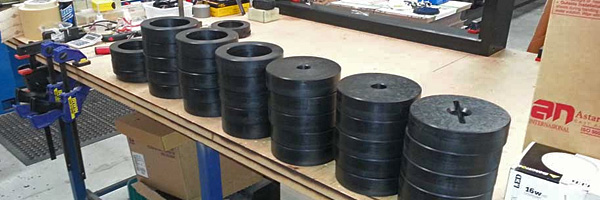A Look at Engineering Plastics and their Applications
December 8th, 2014
A compact introduction to the properties that define all high-performance engineering plastics is a difficult prospect to undertake, especially when we acknowledge the sheer scale of polymer fabrication that’s penetrated into every industry over the last half century or more. Manufacturing plastics, synthetic materials designed to be rugged in application and versatile to manipulate, have surpassed expectations on every front, entering high-performance areas of application where carbon-strengthened steel was once the only option. Now, instead of a metal that exhibits a handful of positive characteristics, engineers have access to tailor-made polymers with countless features.
One way to simplify any task is to take the divide and conquer approach, to split a task into manageable chunks and define each one with plenty of details. Let’s try this method with our study of engineering plastic. This series of polymers diverges from commodity plastics. They’re defined by chemical complexities and tolerance parameters that translate into real world engineering properties that work best in scenarios where mechanical stresses and high-energy forces are apparent. For example, a polycarbonate fabrication cycle incorporates durability factors and temperature constraints. It would be atypical to use this specially formulated material as a simple plastic bag or a storage medium. Indeed, engineering plastics lean heavily toward functionality in their manufacturing dynamic, toward industrial-grade hallmarks demonstrated by elasticity, rigged construction, electrical conductivity, glass-transition temperature, and a host of other factors that can only be properly interpreted by polymer engineers.
Engineering plastic properties at a glance
- Thermal and mechanical characteristics
- Chemical resistance
- Moisture retention
- Versatility through additive injection
This is by no means a complete listing but rather a sampling of the characteristics held within the complex molecular structure of this highly functional group of polymers. Typically manufactured from thermoplastics, a ductile and mouldable plastic that melts when heated, popular forms include ABS (Acrylonitrile Butadiene Styrene), Polyamide, Polyimide, Polycarbonate, and a range of fluorine-based polymers that include Teflon. Again, this selection is incomplete, but it does represent a respectable section of the market. On top of the individual classes of plastics designed for engineering purposes, each substance possesses modifiers that can be regulated by the injection of an additive during the manufacturing process, a feature that makes plastic far more adaptable and affordable than a comparable metal-based facility that requires foundry equipment and huge amounts of heat to run.
Due to their purpose-formed design ethic, engineering plastics are manufactured to act as abrasion-resistant components and chemically immune parts, as gears and pipes integrated within heavy machinery. They’re also consistently found in aeronautical parts due to their lightweight nature. Automotive designs are also the domain of numerous engineering plastics, with superior variants now entering heavily stressed territory such as the engine manifold.
Get in touch with Industrial Plastic Solutions
Mobile: 0400967210
Phone: (03) 9798 1153
Fax No: (03) 9798 1915
Email:
ipssolutions@bigpond.com
Address:
Factory-20, 29-39 Kirkham Road West, Keysborough VIC-3173
Business Hours:
Monday – Thursday 8.30am to 4.30pm
Friday 8.30am to 3.30pm
Saturdays by appointment only.
Optimized by NetwizardSEO.com.au







